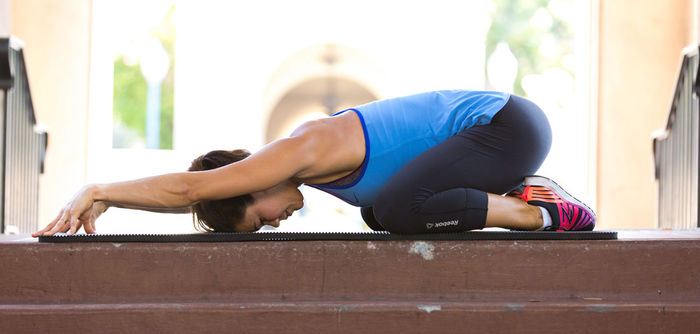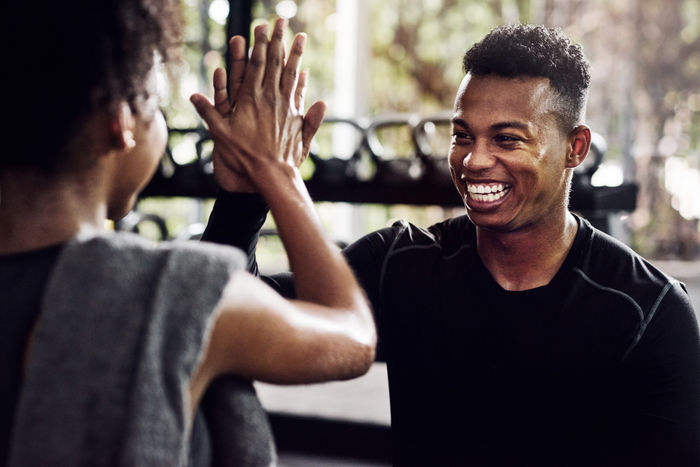This article is from our friends over at Precision Nutrition and is republished here with their permission.
If you want to achieve your health and fitness goals, you need a powerful formula, something to organize your efforts. In this article we’ll help you get organized while covering three important strategies for turning ‘bad’ fitness goals into ‘good’ ones.
What, exactly, are your fitness goals?
Any effort to “get in shape” starts with this question.
It seems like an easy question to answer.
Just rattle off how many pounds you want to lose, what pant size you want to wear, how much weight you want to deadlift, or the date you need to look photo-ready… and you’re on your way.
Of course, that’s how most people set their fitness goals. But are they doing it right?
Usually not.
That’s why we spend a lot of time helping our coaching clients define and set the right kind of goals.
When you set your goals up properly, you have a simple, elegant, action-inspiring blueprint. You know exactly how you’re going to build the skills you need to get the body you want.
Proper goal setting is a plan for getting things done. When you do goals right, you feel ready, willing, and able to make your dream happen.
When you don’t know how to set goals, you get lost. Confused. Overwhelmed. Crushed by “shoulds”. Distracted by wondering and worrying, or by irrelevant details. If you succeed with poor or unclear goals, it’s probably by accident.
Mastering the skill of goal setting is powerful.
Early in the development of our PN Coaching and Certification programs, we realized it wasn’t enough to talk about the kinds of goals that work and the kinds that don’t.
We needed a formula that our own coaches (and Certification grads) could use with clients. One that was easy to understand and implement.
We needed a formula that could be applied to any desired outcome — from losing weight, to getting off cholesterol meds, to feeling good about where you are in life.
Today, I outline that formula.
Read on for three important ways to instantly transform “bad” fitness goals into “good” ones.
Step 1:
Turn “outcome goals” into “behavior goals”.
Generally, when someone asks about their fitness goals, most people start with the outcome(s) they want:
- I want to lose 20 pounds.
- I want that thin-skinned, ripped look.
- I want to binge less often.
- I want to deadlift double my bodyweight.
Outcome goals describe how we want things to be at the end of the process.
There’s nothing wrong wanting things. Or talking about what you want. Or starting with the end in mind.
But we can’t stop there.
Wanting things isn’t enough. Even if you really, really, really want them.
Because: We often can’t control outcomes.
Outcomes are affected by environmental things. Like:
- Your job gets crazy busy.
- Your kid gets sick.
- Your gym closes for renovations.
- Your mom with dementia needs help.
- You have exams at school.
And they’re influenced by physical things. Like:
- Your hormones get out of whack.
- You have a chronic illness. (Or even just a tough bout with the flu.)
- You’re stressed.
- You’re traveling a lot.
- You’re getting older.
- You’re having problems sleeping.
- You sprained your ankle or your arthritic knee is doing its thing again.
You get the idea.
You can’t make your body do what you want it to. (And neither can your personal trainer.)
But you can control what you do.
That’s why behavior goals are so important: They focus on the things we do have control over.
Behavior goals represent your commitment to practice a particular set of actions or tasks every day, as consistently and regularly as possible.
Here’s a practical example.
Client:
“I want a flat stomach.”
Coach:
“Okay, cool.
“Let’s write that down as the outcome you want.
“Now let’s think about all the little steps we can take to move you toward that outcome, and which ones should come first.
“In my experience, here’s a step that makes a huge difference, and it’s a great place to start.
“It’s very simple but incredibly effective: Eating slowly.
“I know it doesn’t seem to relate to ‘flat stomach’ right away.
“But in fact, eating slowly helps you pay more attention to what you’re eating and how. That means over time, you make better food choices easily and effortlessly.
“Eating slowly helps you eat a bit less, but still feel satisfied. It helps decrease bloating because now you’re chewing and digesting your food better, which is another plus for Project Flat Stomach.
“Would you be willing to try this first step of eating slowly, and also to track whether you practice this?”
Since eating slowly helps folks eat less, and eating less most often leads to fat loss (not to mention the benefits of better food choices and better digestion), this approach helps turn an outcome (uncontrollable) into a behavior (controllable).
Here are a few other examples of how we can turn outcome goals into behavior goals.
| Outcome | Behavior |
|---|---|
| Lose 10 pounds. | Eat till satisfied (instead of stuffed) at each meal. |
| Lower blood sugar. | Eat fruit for dessert, instead of sweets, at least three times a week. |
| Squat more weight. | Squat 3 times a week at various intensities. |
| Sleep 8 hours per night. | Create a calming pre-sleep routine and start it 30 minutes before bedtime. |
| Have a better relationship with partner. | Have a date night once a week. |
So how can you set powerful behavior goals today?
- Write down one outcome you want. Don’t overthink it. Just name the desire you want most right now.
- Write down some of the skills you think you’ll need to get that outcome. If you’re just starting out, focus on foundational skills. What are the basics that make everything else possible? (For instance, if you want to manage your time, you need to learn to use a calendar.)
- Related to each skill, write down a behavior or two you can do today that’ll help build those skills. This can be really easy, like walking through the gym doors or even packing your gym bag for tomorrow morning.
- Do the behavior today, and tomorrow, and so on. And, keep in mind, if you don’t follow through on a given day, don’t let it derail you. Each day is a clean slate.
Want help breaking outcomes into skills and skills into behaviors? Check out this cheat sheet.
Step 2:
Turn “avoid goals” into “approach goals”.
Stop drinking soda.
Stop eating junk food.
Stop smoking.
“Avoid” goals like these are nice and straightforward. What’s simpler or easier to understand than “don’t”?
This seems logical. “Don’t” or “stop” will push you away from something “bad”, or something that threatens what you want to achieve.
Yet “avoid” goals are psychologically counterproductive.
Because telling yourself to stop doing something almost guarantees you’ll keep doing it.
As you might imagine, nobody likes being told what to do. This is called resistance, and it’s completely normal. The moment someone (even yourself) argues strongly for change, your natural reaction is to argue equally strongly against change.
What’s more, if the goal is to stop doing something, even the smallest slip can feel like a failure. One miss means you’re “off the wagon” and all hell breaks loose.
“Avoid” goals are a lot of psychological work. They take up a lot of mental and emotional real estate and energy. All you can think about is what you’re not doing… or shouldn’t do… but really want to do… but you’re not allowed to do it… augh.
That’s why we help clients turn “avoid” goals into “approach” goals.
“Approach” goals pull you toward something desirable (and quietly pull you away from something you’re trying to avoid).
“Approach” goals also focus on feeling good. About doing good for ourselves.
Here are some examples of how we can turn “avoid” goals into “approach” goals. Note how approach goals are about adding and enjoying “good stuff” rather than taking away or avoiding “bad stuff”.
| Avoid | Approach | Benefit |
|---|---|---|
| Stop snacking on “junk food”. | Snack on cut-up fruits and veggies prepared in advance. | Fruits and veggies are good for me, and this helps me get more of them. |
| Stop over-eating when stressed or overwhelmed. | Stay “checked in” and practice eating slowly and breathing between bites. | I feel so much calmer, I enjoy mealtimes more with my family, and my digestion is better. |
| Stop drinking soda. | Drink a glass of water with at least 3 meals each day. | I don’t get headaches or constipated any more. |
| Stop eating when I’m stressed out. | Come up with a list of stress-relieving activities that I enjoy. Then pick one from the list and do it. | I feel so much better after my “stress-relief break”! |
| Stop feeling so fatigued and sleep deprived all the time. | Develop a relaxing sleep ritual and 9 pm bedtime. | I am clear-headed, energized, and happy. I need less caffeine now. |
So how can you set powerful “approach” goals today?
- Write down a “bad” habit you want to avoid. This is pretty easy. It’s the “hard to break” behavior you nag yourself about a lot.
- Write down a “good” habit or two you can use to replace the habit you want to quit. Try to make the “good” habits relevant to the context. If you usually take a smoke break at work, take a tea break instead, for example.
- Write down an “approach” goal you can do today to support the new “good” habit. Start as small as you want. Maybe you take the tea break today — or maybe you just bring your new tea stash to work today so it’s ready for you tomorrow.
- Identify how this “approach” goal will benefit you. Brainstorm all the good things that your tea break could bring: you get antioxidants, you can try all different kinds of tea, you can use the adorable mug your daughter made you in pottery class, you can hang out in the break room with that attractive coworker who also likes tea, you’ll smell like fragrant jasmine or vanilla rooibos instead of cigarette smoke… whatever.
- Find what works, and repeat. You can try a bunch of different “approach” goals to find out what feels easiest for you. When you find one that works for your life, practice it every day.
Step 3:
Turn “performance goals” into “mastery goals”.
Performance goals are a lot like outcome goals. But they’re usually associated with external validation such as wanting to get good grades from a teacher, win a competition for the fans, or race against a standardized time.
Just like outcome goals, performance goals are often limited by factors outside your control:
- It could be rainy and windy on the day of a marathon. That’s out of your control, yet influences your time.
- You could get a head cold, an upset stomach, or mega-period-cramps on the day of a powerlifting meet. You may not perform well or set that personal record.
- You could show up in top form at a bodybuilding competition. But your opponent could show up in better form.
Of course, performance goals can be fun for a while. They can push you to achieve your best.
But it’s incredibly demotivating if they don’t work out. Every time you don’t achieve the performance standard, you may think you’ve “failed” (regardless of whether it even makes sense to meet that standard).
And performance goals put our happiness and satisfaction in the hands of someone or something else. Like pleasing a coach. Beating a competitor. Matching an arbitrary number. Having lots of social media “likes”. Or getting a gold star.
We never really feel like we accomplished something because we’re always looking over the fence.
Mastery is different.
- Mastery emphasizes the process of getting a little bit better each day at a particular skill. You don’t expect to be a black belt a quickly as possible. But you do expect to progress… a little at a time.
- Mastery focuses on the joy of learning and the value in intrinsic (inside-yourself) process. External validation becomes irrelevant when you’re focused on the pleasure of doing the activity itself.
- Mastery is gratifying because no matter what others think or do — whether you’re judged poorly or you’re outperformed — you can still feel good about your own personal progression.
Truly, mastery is motivating no matter what else is going on.
But wait, you’re thinking, I’m an athlete.
Or maybe: My clients are athletes. Athletes are defined by performance goals.
They might be during competition. However, during the day-to-day grind, the best athletes I’ve ever worked with have focused on mastery almost exclusively.
The intrinsic pleasure of a growth mindset, of learning each day, and of making improvements is what keeps them training for years. And top performance comes from mastery.
After a disappointing play, or game, or season, mastery-oriented athletes don’t question the value of the activity, or of themselves. They don’t feel like losers. They see losses as essential learning opportunities.
And let’s imagine a situation where performance can’t get better. Let’s imagine that an athlete is winning everything, performing their absolute best — at the very top of their class, with few competitors to challenge them. If there’s no one else to beat, what do you train for? Mastery.
Here’s an example of this in action.
As many of you know, I’ve long worked with former UFC champ Georges St-Pierre. Back at UFC 111 in New Jersey, the crowd saw GSP completely dominate his opponent (Dan Hardy) for 5 grueling rounds and 25 minutes of fighting.
What the crowd didn’t see was that Georges was dissatisfied. When given the opportunity, he didn’t submit his opponent via armbar and the fight went to a decision.
What did he do? At midnight, immediately after the fight ended, hell-bent on perfecting his technique, he went backstage and spent 30 minutes working on armbars with his grappling coach.
That’s what mastery looks like.
Another example comes from Jahvid Best, elite NFL running back who recently retired from football and started competing as a sprinter. When asked about his track and field goals he replied simply: “To master the technique of sprinting”.
He didn’t talk about winning this competition or that one. He didn’t talk about his 100 m times. He talked about mastering his craft.
Here are some examples of how we can turn performance goals into mastery goals. Notice how mastery goals involve words like “work on”; “build”; and “practice”.
| Performance | Mastery |
|---|---|
| Beat a personal record in the half marathon. | Work on running elegantly, efficiently, and smoothly. Watch video of self running and identify technique elements to improve, then incorporate these into training plan. |
| Bench press more weight. | Work on increasing bar speed and strengthening supporting muscles; consistently practice exercises that do this. |
| Beat last year’s time in the Tough Mudder. | Build up lactate tolerance through high intensity anaerobic sprints |
| Drop body fat to 8% for an upcoming competition. | Build my ability to consistently prepare and execute a well-designed meal plan. |
So how can you set powerful “mastery goals” today?
- Write down a desired outcome that’s a performance goal. This could be obvious, or it could take some digging — like: “Damn, why am I so focused on lifting more weight than my brother-in-law?
- Write down some ideas for turning inward with that goal. If you take the external validation out of the equation, what does success look like? What do you want to master… for you? For the craft?
- Think about which skills will lead to mastery. Not to a faster time. But to a body that can produce faster times or higher jumps or smoother movement or better decisions made more consistently.
- Write down an action you can take every day for the next two weeks to build those skills. Then take the action. (Our clients have a lot of fun with this one, because it tends to totally transform and renew workouts, meal planning, and other health-related regimens. It becomes about practical progression. It can even become a game.)
- Track your progression toward mastery. Make your practices a permanent part of your daily or weekly routine. Have fun tracking your progress. And high five yourself for all progress, no matter how small.
So, why set the right kind of goals?
The right goals can help you set realistic expectations and break large projects into smaller pieces. This avoids overwhelm and helps you stay committed.
The right goals help you feel “in charge”: autonomous, accountable, and responsible for your own life. This is a good feeling. You need it for sustainable change.
The right goals set you up for long-term understanding and inspiration that “sticks”. (Rather than short-term “quick fixes” that ultimately fail or frustrate.)
The right goals boost your own intrinsic motivation. They’re meaningful to you, rather than being about someone else’s judgement, standards, or agenda.
The right goals help you take action. Right now. In real ways. In your real life. Because in the end… only action leads to change.
What to do next:
Some advice from Precision Nutrition.
1. Take an honest look at your goals.
Most people have health and fitness goals. Think about yours. Write them down if you like.
Review and sort them. Which ones are “outcome goals”, “avoid goals” and/or “performance goals”?
If any are, how long have you had them? Do you feel good about your progress? How are they working for you?
2. Consider the skills you need to do what you want.
New outcomes need new skills. If there’s something you want to do, and you haven’t done it, you probably haven’t developed the skills you need. (Yet.)
Consider which skills you’ll need to build and how you’ll build them.
3. Turn outcomes into behaviors.
Once you know which skills will help you reach your goals, break them down into behaviors/actions you can practice with purpose every day.
4. Focus on what to do, rather than on what not to do.
“Don’t do X” is not an action plan.
But “Do more Y” is.
Where possible, go towards “good stuff”: benefits, enjoyment, pleasure, abundance, learning, growth, and satisfaction.
5. Enjoy the journey.
Choose behaviors you’ll enjoy (or find ways to enjoy the behaviors you’ve chosen). Experience the daily zen of doing a thing for its own sake. Refine, improve, and become a master.
If you’re a coach, or you want to be…
You can help people build nutrition and lifestyle habits that improve their physical and mental health, bolster their immunity, help them better manage stress, and get sustainable results.
If you’d like to learn more, consider the Precision Nutrition Level 1 Nutrition Coaching Certification or Sleep, Stress Management and Recovery courses!




 by
by 







